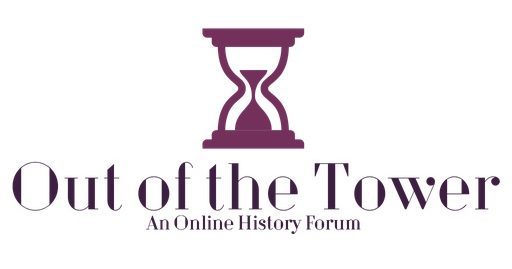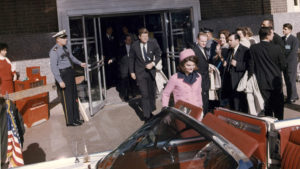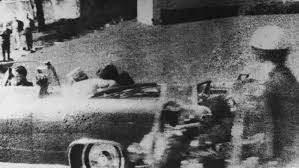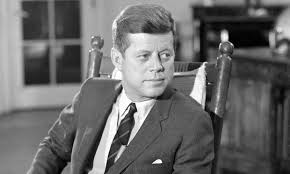My husband was away for an intense two-week business trip, so I was left to care for our two wonderful, but utterly demanding toddlers on my own. Needless to say, life has been hectic. In the midst of the craziness, I have been intending to write a piece on the Watergate Scandal and its implications for the Russia investigation that is entangling our current president. Yet, something tremendous has happened over the past week and its historical importance demands our attention. (I know, I know; I keep promising a Watergate post. I will get to it, I promise!) But, first, let’s discuss the 2017 release of the JFK records.
Full Disclosure: As an undergraduate history major at The George Washington University, I worked as a researcher for Jim Lesar, the president of the Assassination Archives and Research Center (AARC). Lesar taught me invaluable research lessons. With him, I first went to the National Archives in College Park, MD and FBI Headquarters in DC. Under his guidance, I went through portions of the JFK files that were available then, as well as materials relating to J. Edgar Hoover’s private notes. Lesar taught me to question everything; to embrace copious details; and treat all pieces of information like parts of a puzzle. Moreover, Lesar opened my eyes to the thorny and intricate case that is the JFK assassination. You could say, then, that Lesar pushed me down the rabbit hole.
As I learned, the JFK assassination is more complicated than what the Warren Commission concluded in September 1964. According to the Commission, one man, Lee Harvy Oswald, murdered President Kennedy for reasons only known to himself. The Commission’s findings stated that Oswald fired at the President as he drove through the city of Dallas, a crime that Oswald vehemently denied. This sniper, according to the Commission, had been waiting in the window of a warehouse and he killed the president with just two accurate rifle shots. The crime was simple, the Commission suggested, a lone shooter had killed the president. There was no conspiracy, it asserted. But the Commission also made no suggest that Oswald was insane and it failed to explain why their alleged killer would want the president dead.[1]
While the Warren Commission is often labeled as the only official inquiry into the case, there have actually been several government investigations that have looked into the Kennedy assassination: the Garrison Investigation; the Rockefeller Commission; the Church Committee; the House Select Committee on Assassinations; and the Assassination Records Review Board. These investigations showed that government organizations (mostly intelligence agencies) concealed evidence and partook in official misconduct after JFK was killed. The CIA, for example, did not disclose to the Warren Commission that its agents were seeking to assassinate Cuban leader Fidel Castro at the time of JFK’s murder. It also failed to disclose that its counterintelligence staff had been monitoring the movements and activities of Oswald for four years before JFK’s assassination.[2]
Arguably, the most important of these other investigations is the House Select Committee on Assassinations (HSCA). After the Church Committee in the 1970s uncovered a profound history of abuse by US intelligence agencies and after the airing of the Zapruder film on television in 1975 showed President Kennedy reacting “the wrong way” to a bullet from the rear, the public demanded another major investigation into the JFK case. In 1976, Congress reacted and by an overwhelming majority, it voted to conduct its own probe. In 1979, the Committee issued its final report, concluding, “Kennedy was probably killed as a result of a conspiracy.”[3] Take a second to read that again. Yes, the United States Congress concluded that Kennedy was likely killed because of a conspiracy. Thus, the US government’s record of JFK’s death actually has two official narratives: 1) he was killed by a lone shooter; 2) he was killed as a result of a conspiracy.
The HSCA based its finding in large part on acoustics evidence that captured the sound impulses of gunfire in Dealey Plaza. A distinguished acoustic expert, appointed to analyze a sound-recording made on the day of the assassination, concluded that there were four shots and that they came from more than one location. This meant that Oswald alone could not have possibly fired all four shots in the time available. The expert also noted that the third shot appeared to have originated from in front of the president, not from behind where Oswald allegedly shot his victim. Before issuing its report, the HSCA called two more scientists to analyze the evidence, and they agreed to a scientific certainty that there had indeed been more than one shooter.[4]
Oliver Stone, who I also happened to have worked for years later when I was a PhD student, reignited public fascination with President Kennedy’s murder with his 1991 film, JFK. At the end of the film, Stone called attention to the massive number of government records pertaining to the case that were still locked away. Because of the public firestorm that erupted, Congress passed the 1992 President John F. Kennedy Assassination Records Collection Act. The law set up a process for declassifying the government files on the JFK case. It also set up the Assassination Records Review Board (ARRB) as an independent body to oversee the declassification process. Throughout the 1990s, the AARB released millions of pages of records from the FBI, CIA, Warren Commission, HSCA, and other government bodies. While the AARB did not reinvestigate the JFK murder, it did conduct interviews with government personal (CIA agents; autopsy participants) in its search for records.
So, why is the recent release of documents important? The JFK Records Collection Act stipulated that “each assassination record shall be publicly disclosed in full, and available in the Collection no later than the date that is 25 years after the date of the enactment of this Act…”[5] That date was October 26, 2017. This means that by law all the records pertaining to the JFK assassination were to be released to the public in full with no redactions. According to JFK researcher Rex Bradford of the Mary Ferrell Foundation, a monumental source of digitized records pertaining to the case, this meant releasing the 3, 147 records that had been withheld in full and another 35,000 documents that had previously featured redactions.
But, at what seemed like the last minute, President Trump decided to not release all the records. As Bradford put it, “What Happened Thursday with the JFK Records? A travesty.”[6] While most news reports are correct that the government did release about 2,800 documents, they are wrong to suggest Trump’s order only withheld “some” materials. In fact, as Bradford explains, tens of thousands of documents have remained sealed. After intense pressure from federal agencies, most notably the CIA, Trump decided to withhold over 90% of the records. Only 52 of the 3,147 withheld-in-full records have been released and only 2,839 of the 30,000 redacted documents have been released. By looking through the public metadata of these materials, Bradford noted that the still sealed records maintain several important documents: Church Committee interview transcripts with notorious CIA counterintelligence Chief James Angleton, who was fully aware of Oswald for years prior to Kennedy’s murder; lengthy CIA files on officers who played a role in Castro assassination plots including William Harvey, David Phillips, E. Howard Hunt (of Watergate fame), James O’Connell, and others; a transcript of an interview the HSCA conducted with Orest Pena, a New Orleans bar owner who told the Committee that Oswald was an FBI informant; a 167-page CIA document on Valerity Kostikov, a known KGB assassin who Oswald sought out when he traveled to Mexico City the summer before JFK’s murder; and many, many more documents. And, as Bradford points out, many of the released documents still feature redactions, even though the act specifically states that materials should be released in full.[7]
Now, the act did stipulate that the materials could still be withheld if the current president deemed that the release of certain documents could threaten national security.[8] According to President Trump’s order, he has called for a review process to take place over the next six months to decide whether he should allow for full disclosure of all the records or to continue the veil of secrecy. To keep the materials sealed, the law requires that the petitioning agencies prove that the release of certain documents will cause “identifiable harm of such gravity that it outweighs the public interest in disclosure.”[9] My response? I think, Robert Baer, a former undercover CIA officer, put it best: “There’s no sources and methods involved. Release [the records], and let’s clear this up.”[10] Right? Let’s clear this up, already. It’s been over fifty years. At this point, I cannot help but ask: Will our government ever adhere to the public’s right to full disclosure about the circumstances surrounding the murder of President Kennedy?
To be sure, all hope is not lost. As scholars and researchers have shown since the National Archives started releasing more JFK materials this past summer, the new records have given more kernels of information and they have helped to put more pieces of the puzzle together. As JFK researcher Jefferson Morley demonstrates, we know that top CIA official, James Angleton, had known about Oswald since November 1959 and he had been aggressively interested in Oswald’s activities up until the president’s death.[11] Also, as historian John Newman has demonstrated, we know that the CIA was heavily monitoring Oswald’s movements in Mexico City the summer of 1963. We also know that the CIA was aware of someone impersonating Oswald and making calls to the Soviet Embassy in Mexico City that summer. And, as Newman revealed, the CIA partook in a cover up of this information in the wake of the president’s murder.[12]
But, why? Why conceal this information? Does it show incompetence on the part of the agency? Does the information show that the CIA failed to take Oswald seriously enough? Or, does the information reveal a deeper connection that allowed conspirators to avoid the scrutiny of investigation? It is my hope that the release of more documents will help shed light on the contours of the CIA’s tantalizing links to Oswald.
Indeed, the release of the still sealed records will hopefully paint a fuller picture of Oswald himself, someone who has quite an extraordinary personal history. Before his death at the age of twenty-four, he had already served as a radar operator at a top-secret base for American espionage operations. Afterwards, he spent years in the Soviet Union as a supposed defector, but then he was let back into the United States with a Russian wife. He then apparently dabbled in Cuban revolutionary politics.[13] But, as Rex Bradford asks, “Was Oswald a [leftist] malcontent…or was he instead something altogether different–an agent of a U.S. intelligence agency operating under cover, building a ‘legend’? And was that legend then used against him on November 22, 1963?” [14]
I should be clear on one final point: I do not think we will find a smoking gun in the new JFK records. The remaining records will not give us the quick, easy answers that the rushed atmosphere of the 24-hours news cycle craves. This does not mean that the records are inconsequential. As a society, we desperately need to move away from our growing tendency to ignore complexity. The complete and un-redacted release of the remaining JFK records is vital and we should continue to demand their release from our government. Access to that information is our right. But, we have to understand that the records are mere pieces to a gigantic puzzle. They are not the answers in and of themselves. And, the answers that they will eventually yield will not be simple. To understand what happened in Dallas on that day, we have to not only collect all the puzzle pieces, but also put them together through patient and meticulous analyses. Only in this manner will we reach the thorough interpretations that are needed to illuminate what has been left out of our historical record for far too long.
[1] Anthony Summers, Conspiracy: The Definitive Book on the JFK Assassination (New York: Paragon House, 1989), xviii.
[2] Jefferson Morley, “Top 4 Revelations From the New JFK Files,” Alternet, 12 September 2017, https://www.alternet.org/top-4-revelations-new-jfk-files (accessed 30 October 2017).
[3] “House Select Committee on Assassinations (HSCA), Mary Ferrell Foundation, https://www.maryferrell.org/pages/HSCA.html (accessed 30 October 2017).
[4] Yes, I know that over the years the acoustic evidence has come under fire, most notably from the National Academy of Sciences (NAS). The NAS found several errors in the original analysis. But, in 2001, Dr. Donald B. Thomas published another study in the British Journal Science and Justice, which undermined NAS’s criticism. See “Conspiracy: Cases For and Against,” Frontline, 20 November 2003, http://www.pbs.org/wgbh/pages/frontline/shows/oswald/conspiracy/ (accessed 30 October 2017); and, Summers, Conspiracy, xviii-xix.
[5] Rex Bradford, “Mark the Date: Oct 26, 2017,” Mary Ferrell Foundation, https://www.maryferrell.org/pages/Featured_Mark_the_Date.html (accessed 30 October 2017).
[6] Rex Bradford, “What happened Thursday with the JFK Records?” Mary Ferrell Foundation, https://www.maryferrell.org/pages/Featured_What_Happened_Thursday.html (accessed 30 October 2017).
[7] Bradford, “What happened Thursday with the JFK Records?”
[8] Bradford, “Mark the Date: Oct 26, 2017.”
[9] Bradford, “What happened Thursday with the JFK Records?”
[10] Jefferson Morely and Rex Bradford, “Donald Trump and the Kennedy Assassination: America’s Most Powerful Conspiracy Theorist Will Decide Fate of Secret JFK Trove,” Newsweek, 21 June 2017, http://www.newsweek.com/2017/07/07/trump-jfk-kennedy-assassination-documents-secret-cia-russia-cuba-oswald-deep-627751.html (accessed 30 October 2017).
[11] Jefferson Morely, “CIA Spyhunters Knew Lee Harvey Oswald was in Dallas Days Before JFK’s Assassination,” Daily Beast, 26 October 2017, https://www.thedailybeast.com/cia-spyhunters-knew-lee-harvey-oswald-was-in-dallas-days-before-jfks-assassination (accessed 30 October 2017).
[12] John Newman, “Oswald, the CIA, and Mexico City,” Frontline, 20 November 2003, http://www.pbs.org/wgbh/pages/frontline/shows/oswald/conspiracy/newman.html (accessed 30 October 2017).
[13] Summers, Conspiracy, xviii-xix.
[14] “Lee Harvey Oswald,” Mary Ferrell Foundation, https://www.maryferrell.org/pages/Lee_Harvey_Oswald.html (accessed 30 October 2017).








